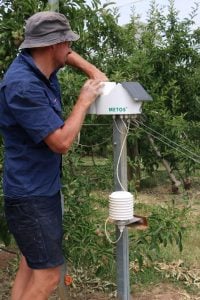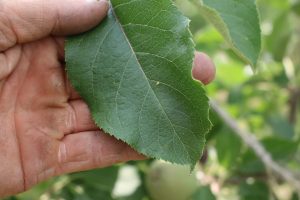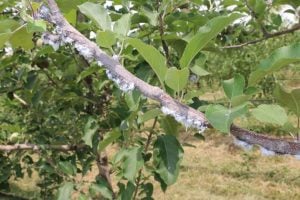| Grower name: | Jeremy, Michael and Sharon Smart |
| Location: | Tingira Orchard, Batlow |
| What are the main IPDM issues being focussed on? | Focus on Woolly Apple Aphid (WAA) and Codling Moth (CM) continued with the implementation of an earwig monitoring trial and installation of new weather station with degree day prediction model for CM. Mites are likely to become the focus in January 2020 particularly given the hot conditions being experienced in recent days.
 Case study grower Jeremy Smart checking the rain gauge of his new Metos weather station.(Photo K Dodds NSW DPI) |
| What are you doing currently with IPDM? | WAA : We have been monitoring rolled cardboard traps since before bloom, to determine if there are sufficient earwigs present to effect biological control. The traps have yielded zero earwigs. We have been avoiding all insecticides known to be toxic to earwigs and we have also Inoculated the block to try to establish a population for the future. We are continuing to monitor the traps to check if the inoculation has been successful.
In November, we made releases of Aphelinus mali from shoots stored from late last season. Codling moth : We monitored pheromone traps to determine a biofix in Spring and used this date to start accumulating Degree Days with our new Metos weather station and the RIMPro software package. As at 19th December, we have applied two Altacor sprays for control of CM. We used images in the NSW Orchard Plant Protection guide to show our fruit thinning staff what to look for and asked them to keep any fruit they found with stings. After many days of thinning in areas where we had a problem last season, our staff have only found two pieces of fruit with damage. We are very happy with this result. Apple Scab : Our weather station has also helped us to manage our apple scab spray program relative to the local infection pressure. Our observation has been that monitoring weather conditions on our own property has improved our understanding of pest and disease activity and improved our confidence in spray timings.  A juvenile Apple Dimpling Bug on apple leaf in the case study block. ADB are considered beneficial in apple oprchards outside of the potential damaging period of Pink-Petal fall (Photo: K Dodds NSW DPI) |
| What has worked well? What hasn’t? | WAA – At the November IPM orchard walk, we saw good numbers of A.mali on leaves in the case study block and WAA colonies seemed to be in check. This situation changed in December. On 11th December a check of trees that were heavily infested with WAA last season showed little aphid activity and it looked as though the pest might be under biological control from A.mali. One week later (19th December) WAA colonies have flared-up significantly and there was no clear evidence of effective parasitism by A.mali. Nothing has been applied to cause this increase in WAA activity. The increase appears to be associated with an increase in hot weather conditions. At this stage we are monitoring the infestation and intend to give the parasitic wasps an opportunity to establish.
 Unfortunately the hot weather seems to have caused the WAA to flare up, despite having good A.mali numbers in November (Photo: K Dodds NSW DPI)
CM – Timing of sprays using on orchard temperature data and degree days has worked well so-far this season. |
| What would you do differently next time? | WAA – We will continue to avoid insecticides known to be toxic to earwigs and will try to build suitable habitat to encourage an increase in these beneficial insects.
CM – Happy with progress on CM spray timing and control result. Will continue to monitor traps and the RIMpro model to time mid-late season sprays if necessary. Mites – Will be keeping a close eye on mite activity in January-February. |
Click here for more Case Study Orchard updates
